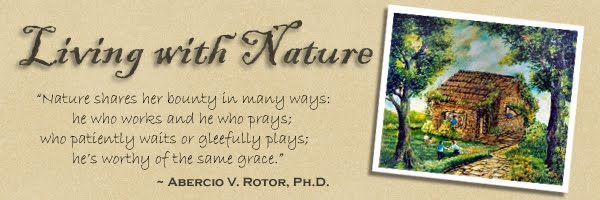Woodland in the City
(Arboretum of the University of Santo Tomas, Manila)
Dr Abe V Rotor

Talisay tree (Terminalia catappa) or umbrella tree in its incipient deciduous stage. With the coming of Amihan season the leaves turn golden yellow to orange and red, then fall off to the ground leaving the tree a almost bare. New leaves will soon replace the crown.
Fire tree (Delonix regia) during its non-flowering season is a lush towering tree, its leaves almost blocking the sun. At the onset of summer, its leaves fall off and are replaced by clusters of fire red flowers, hence the name of the tree.
Dita (Alstonia scholaris) is the tallest tree on the campus, surpassing the height of the main building sans its tower cross.
Dita (Alstonia scholaris) is the tallest tree on the campus, surpassing the height of the main building sans its tower cross.

Another dita tree, also in the Botanical Garden proper, is estimated to be one hundred years old. Dita is very resistant to pollution and to injury. It produces milky sap that immediately closes its wounds. The sap traps insects like a fly catcher entombing victim in the process. Fossil insects are made this way.
Left: Prop roots of rubber tree (Hevea braziliensis), a relative of the balete (right photo). They belong to Family Moraceae which also includes fig, nangka and breadfruit. Here graduate students examine the hanging roots which will eventually become prop roots or false trunks. As the tree grows these prop roots spread out of the central trunk making it appear to be "walking." Centuries old trees like the banyan (Ficus benghalensis) become so massive that they form natural arches and caves.
Anahaw palm (Livistona asiatica) towers over neighboring narra trees (Pterocarpus indicus). Anahaw as well as buri (Corypha elata) are now threatened species.
Anahaw palm (Livistona asiatica) towers over neighboring narra trees (Pterocarpus indicus). Anahaw as well as buri (Corypha elata) are now threatened species.
Camphor trees dominated the front lawn of UST until recently. Cinnamomum camphora (also known as camphorwood or camphor laurel) is a large evergreen tree that is a source of oil, pharmaceutical products and timber. Being sensitive to flooding and pollution, even the older trees such as these in the photo apparently exhibit premature aging. Right, camphor tree laden with climbing Philodendron.
Botong (Barringtona asiatica), produces nut-like fruits that bear seeds poisonous to insects and fish. Graduate students examine the unique shape and structure of the pod.
Antipolo (Arthocarpus sp) tree has broad leaves, perhaps the biggest of the dicots. It is related to nangka and rimas, as well as figs.


Lianas make a natural curtain. Here students conduct field studies in biology and ecology. They study interrelationships of plants - competition, symbiosis, parasitism, succession, etc.
Top view of the Botanical Garden, formerly Pharmacy Garden. It is one of the few gardens in the heart of the metropolis. It is a sanctuary of wildlife displaced by urbanization. Plants are allowed to grow naturally like in a forest.
NOTE: In the strict sense, an arboretum is a collection of trees. Related collections include a fruticetum (from the Latin frutex, meaning shrub), and a viticetum, a collection of vines. More commonly today, an arboretum is a botanical garden containing living collections of woody plants intended as a "living gene bank" and field laboratory. As a park an arboretum adds beauty to the place, and creates a mini-climate in the area. ~















No comments:
Post a Comment